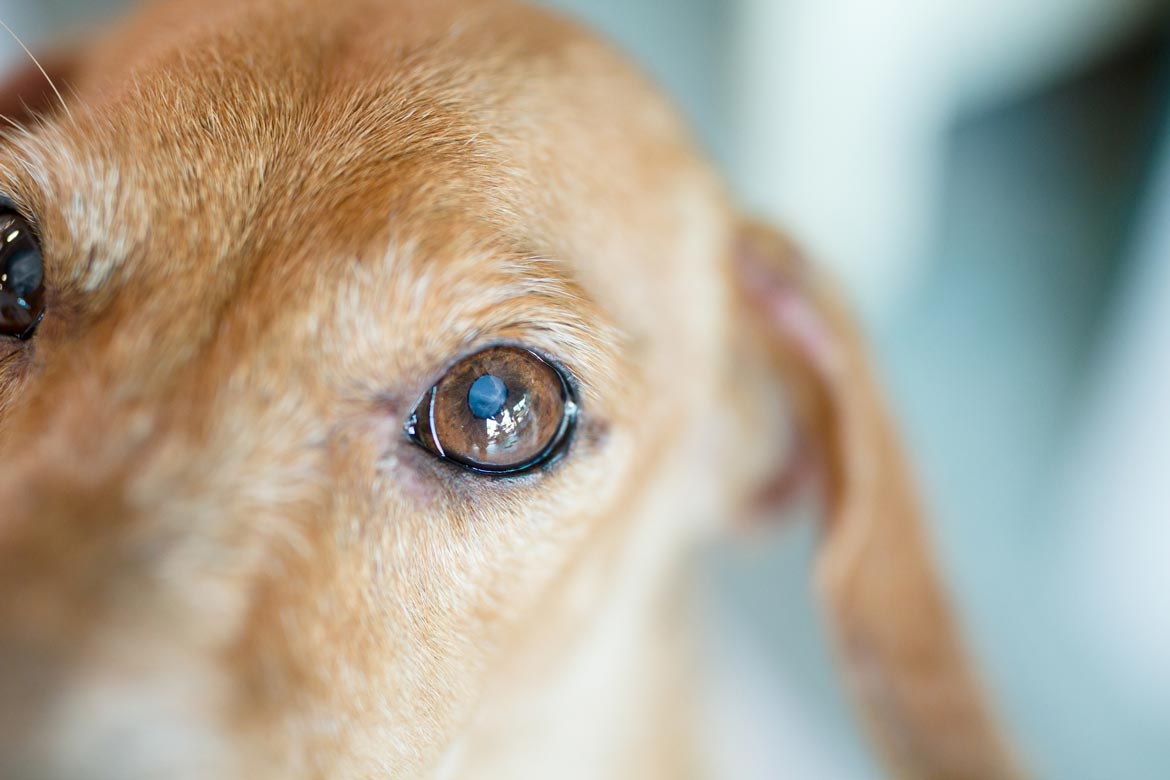How to Care for a Blind Dog

Dogs can be born blind or develop blindness suddenly or slowly over time. Some of the conditions that can cause a dog to become blind include:
- Trauma to the eyes or head
- Glaucoma
- Tumors
- Progressive retinal atrophy
- Cataracts
- Severe KCS
If you have a dog that is blind or going blind, there are a few adjustments you can make in your home, training, and care routines that will help her.
How to Train a Blind Dog
When training a dog that has sight, it's common for people to use visual cues like showing the dog a treat or making hand signals along with verbal commands. For a blind dog, the visual cues must be skipped. Touch and sound have to be used instead to teach your dog what you want.
Use verbal cues during your training sessions with your dog. Try to keep them short—one word is best. Be extremely consistent with the words you use and the tone of voice you employ to say them. Remember, dogs rely heavily on their sight to interpret what their owner wants. They are constantly reading our body language, which we might not even be aware of. A blind dog doesn't have that ability, so saying words precisely the same way each time can help replace that.
Clicker training can be even more valuable with a blind dog than with one that is sighted. That's because the sound of the click can tell the dog much more quickly that she's doing the right thing than we can by saying "yes" or getting a treat into her mouth. Of course, you can still use those positive reinforcement techniques along with the clicker, but the sound should be the first thing you do when your dog responds properly to a command. You can learn more here: "Clicker Training for Dogs: An Overview."
One great command to teach your dog is "Watch." When you say it, your dog should either sit down and wait for your help or change paths, and you'll use it when you see your dog is about to bump into something.
How to Walk a Blind Dog
A blind dog, especially one that used to be sighted, can become nervous on walks. Still, it's great exercise and can provide enrichment as your dog gets to experience sounds and smells that are different from her home.
Start slow when talking your blind dog for a walk. Talk to her as you go, reinforcing commands you're working on in training, such as "Watch."
Start out by taking the same path each time, so your dog becomes familiar and confident with it. Then, you can slowly branch out to taking other routes as your dog becomes more comfortable walking.
Some blind dogs that are just starting out with walks on a leash might stop and refuse to move. Consider getting a harness and leash for a dog that does that, so you have more control and ability to gently get her going again.
Stay calm yourself. Teach your dog to use you for guidance by always staying positive and not getting flustered. If you sound nervous, your dog will think she should be concerned too.
Types of Toys Good for Blind Dogs
Blind dogs need enrichment and play time just like sighted dogs. It can also help them build their confidence about getting around without vision.
But how can you play fetch with a dog that can't see where the toy went?
Some toys make noise when thrown for blind dogs. They might whistle or play a song that continues after it drops to the ground, so a blind dog can find it.
Some toys have special scents embedded in them, which help a blind dog find them from across the room.
Blind dogs also like food-dispensing toys. They can chew on and mess with them until kibbles of food or treats fall out, and the food inside makes them easy for the dog to find by scent.
Other Tips for Helping a Blind Dog
When your dog is blind, try to avoid moving furniture around in your home. Doing so can confuse and upset your dog, who has probably learned how to get around set paths in the house.
If you wear a small bell while you're home, it might comfort your blind dog and help her find you. You can put small bells on the collars of other pets in the home, too, so they're less likely to startle your blind dog.
Feed and water your dog in the same spot all the time, so she knows where to go and how to find her water if you're not home.
You can try using a particular scented spray to help "flag" items like furniture until your dog learns where they are. When she smells it, she'll stop and investigate rather than running into the item.
You May Also Like These Articles:
Disclaimer: This website is not intended to replace professional consultation, diagnosis, or treatment by a licensed veterinarian. If you require any veterinary related advice, contact your veterinarian promptly. Information at DogHealth.com is exclusively of a general reference nature. Do not disregard veterinary advice or delay treatment as a result of accessing information at this site. Just Answer is an external service not affiliated with DogHealth.com.
Notice: Ask-a-Vet is an affiliated service for those who wish to speak with a veterinary professional about their pet's specific condition. Initially, a bot will ask questions to determine the general nature of your concern. Then, you will be transferred to a human. There is a charge for the service if you choose to connect to a veterinarian. Ask-a-Vet is not manned by the staff or owners of DogHealth.com, and the advice given should not delay or replace a visit to your veterinarian.



